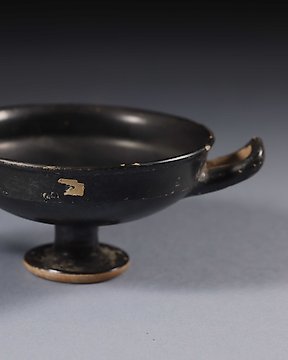
Ancient Greek Attic Kylix glazed ware. 20 cms w.
No. 85155199

No. 85155199

Textile fragment.
Ancient Egypt, Coptic, 6th century AD.
Linen
22.5 cm length.
PROVENANCE: Private collection, Paris, France. Acquired around the 1960's - 1980's.
DOCUMENTS: Provided of a certificate of authenticity and export license by the Ministry of Culture.
CONDITION: Good condition. See photos.
DESCRIPTION:
Many examples of Coptic textiles are preserved, thanks to the custom of including them in funeral trousseau and to the dryness of Egyptian tombs. They are woolen or linen fabrics, in red, blue, yellow, green, purple, black and brown, obtained from blonde, indigo, glastum, saffron, Tyrian purple and carmine.
The first looms were horizontal, and over time vertical ones were introduced. The basic garment was the tunic, which became the dalmatic. Some were woven in one piece and decorated with clavi, a decoration imported from Rome. Some beautiful examples of textiles are exhibited in museums around the world, and the largest collection is in the Coptic Museum in Cairo.
Tens of thousands of colored fragments are part of the collection of many museums, especially after 1889, when the French archaeologist Albert Gayet published a catalog of Coptic art, and the first exhibition of Coptic monuments was held at the Bulaq Museum.
Notes:
- The piece includes authenticity certificate.
- The piece includes Spanish Export License.
- The seller guarantees that he acquired this piece according to all national and international laws related to the ownership of cultural property. Provenance statement seen by Catawiki.
How to buy on Catawiki
1. Discover something special
2. Place the top bid
3. Make a secure payment